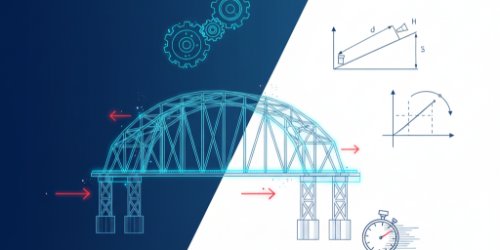Rough surfaces and ball-and-socket joints - 3D Reactions | Equilibrium of Rigid Bodies - Engineering Mechanics (Undergraduate Advanced)
SPONSORED Get Personalized Tutoring NowStruggling with a tough concept or looking to advance your skills? Our expert tutors offer one-to-one guidance tailored to your unique needs.
Get instant support, clear explanations, and practical strategies to master even the most challenging subjects. With flexible scheduling and customized learning plans, success is just a session away.
Book your personalized tutoring today and start achieving your academic goals!
Get Personalized Tutoring NowStruggling with a tough concept or looking to advance your skills? Our expert tutors offer one-to-one guidance tailored to your unique needs.
Get instant support, clear explanations, and practical strategies to master even the most challenging subjects. With flexible scheduling and customized learning plans, success is just a session away.
Book your personalized tutoring today and start achieving your academic goals!
Struggling with a tough concept or looking to advance your skills? Our expert tutors offer one-to-one guidance tailored to your unique needs. Get instant support, clear explanations, and practical strategies to master even the most challenging subjects. With flexible scheduling and customized learning plans, success is just a session away. Book your personalized tutoring today and start achieving your academic goals!
 Equilibrium of Rigid Bodies - Engineering Mechanics (Undergraduate Advanced)Equilibrium is the foundation of all structural and mechanical analysis. This course provides a rigorous study of the equilibrium of rigid bodies in two and three dimensions. It covers reactions, equilibrium equations, constraints, and statical determinacy, supported by extensive worked examples.
Engineers, architects, and applied scientists constantly rely on equilibrium principles to design safe, efficient, and reliable systems. From bridges and buildings to machines and vehicles, every stable structure depends on correct modelling of supports, forces, and constraints. Mastery of equilibrium ensures accuracy in analysis and prevents costly or dangerous failures.
By completing this course, you will be able to draw free-body diagrams, apply equilibrium equations in 2D and 3D, and classify and analyse different support and constraint conditions. You will understand when a system is properly constrained, over-constrained, or indeterminate, and you will have practical experience solving a wide range of equilibrium problems.
This course is intended for undergraduate students in mechanical, civil, and structural engineering, but it is also useful to anyone studying applied mechanics at an advanced level. It provides both a theoretical foundation and practical problem-solving skills valuable to practising engineers, technical instructors, or anyone needing precise understanding of equilibrium in rigid body mechanics.
Equilibrium of Rigid Bodies - Engineering Mechanics (Undergraduate Advanced)Equilibrium is the foundation of all structural and mechanical analysis. This course provides a rigorous study of the equilibrium of rigid bodies in two and three dimensions. It covers reactions, equilibrium equations, constraints, and statical determinacy, supported by extensive worked examples.
Engineers, architects, and applied scientists constantly rely on equilibrium principles to design safe, efficient, and reliable systems. From bridges and buildings to machines and vehicles, every stable structure depends on correct modelling of supports, forces, and constraints. Mastery of equilibrium ensures accuracy in analysis and prevents costly or dangerous failures.
By completing this course, you will be able to draw free-body diagrams, apply equilibrium equations in 2D and 3D, and classify and analyse different support and constraint conditions. You will understand when a system is properly constrained, over-constrained, or indeterminate, and you will have practical experience solving a wide range of equilibrium problems.
This course is intended for undergraduate students in mechanical, civil, and structural engineering, but it is also useful to anyone studying applied mechanics at an advanced level. It provides both a theoretical foundation and practical problem-solving skills valuable to practising engineers, technical instructors, or anyone needing precise understanding of equilibrium in rigid body mechanics.
Equilibrium is the foundation of all structural and mechanical analysis. This course provides a rigorous study of the equilibrium of rigid bodies in two and three dimensions. It covers reactions, equilibrium equations, constraints, and statical determinacy, supported by extensive worked examples. Engineers, architects, and applied scientists constantly rely on equilibrium principles to design safe, efficient, and reliable systems. From bridges and buildings to machines and vehicles, every stable structure depends on correct modelling of supports, forces, and constraints. Mastery of equilibrium ensures accuracy in analysis and prevents costly or dangerous failures. By completing this course, you will be able to draw free-body diagrams, apply equilibrium equations in 2D and 3D, and classify and analyse different support and constraint conditions. You will understand when a system is properly constrained, over-constrained, or indeterminate, and you will have practical experience solving a wide range of equilibrium problems. This course is intended for undergraduate students in mechanical, civil, and structural engineering, but it is also useful to anyone studying applied mechanics at an advanced level. It provides both a theoretical foundation and practical problem-solving skills valuable to practising engineers, technical instructors, or anyone needing precise understanding of equilibrium in rigid body mechanics.
 MEE 205: Engineering Mechanics - StaticsMaster the science of structural stability. This programme provides a complete education in engineering statics, covering the analysis of forces, moments, and equilibrium in rigid bodies. It delivers the non-negotiable principles required to design safe and reliable structures.
This learning track is for first or second-year undergraduate students in Civil, Mechanical, Aerospace, and Structural Engineering. It is the foundational mechanics course upon which all subsequent design and analysis subjects are built.
Analyse the forces within any static structure, from simple trusses to complex machines. You will master free-body diagrams, equilibrium equations, and structural analysis methods. This programme equips you with the core analytical skills for a career in structural, mechanical, or civil design.
MEE 205: Engineering Mechanics - StaticsMaster the science of structural stability. This programme provides a complete education in engineering statics, covering the analysis of forces, moments, and equilibrium in rigid bodies. It delivers the non-negotiable principles required to design safe and reliable structures.
This learning track is for first or second-year undergraduate students in Civil, Mechanical, Aerospace, and Structural Engineering. It is the foundational mechanics course upon which all subsequent design and analysis subjects are built.
Analyse the forces within any static structure, from simple trusses to complex machines. You will master free-body diagrams, equilibrium equations, and structural analysis methods. This programme equips you with the core analytical skills for a career in structural, mechanical, or civil design.
Master the science of structural stability. This programme provides a complete education in engineering statics, covering the analysis of forces, moments, and equilibrium in rigid bodies. It delivers the non-negotiable principles required to design safe and reliable structures. This learning track is for first or second-year undergraduate students in Civil, Mechanical, Aerospace, and Structural Engineering. It is the foundational mechanics course upon which all subsequent design and analysis subjects are built. Analyse the forces within any static structure, from simple trusses to complex machines. You will master free-body diagrams, equilibrium equations, and structural analysis methods. This programme equips you with the core analytical skills for a career in structural, mechanical, or civil design.
 GET 207: Applied MechanicsMaster the non-negotiable principles of Engineering Mechanics. This track delivers a rigorous, complete programme in statics and dynamics, built to the NUC GET 207 core curriculum. It moves methodically from force systems and equilibrium to the kinematics of rigid bodies and the kinetics of particles. This is the foundation of all structural and mechanical analysis.
This programme is for first and second-year undergraduate engineering students. It is an essential requirement for students in Mechanical, Civil, Structural, Aerospace, and Mechatronics engineering. A working knowledge of introductory physics and calculus is assumed.
On completion, you will be able to analyse and solve complex problems in statics and particle dynamics. You will draw free-body diagrams, apply equilibrium equations, analyse trusses and frames, and solve motion problems using Newton's laws, work-energy, and momentum methods. This programme prepares you for advanced courses, particularly Mechanics of Materials, and future professional engineering practice.
GET 207: Applied MechanicsMaster the non-negotiable principles of Engineering Mechanics. This track delivers a rigorous, complete programme in statics and dynamics, built to the NUC GET 207 core curriculum. It moves methodically from force systems and equilibrium to the kinematics of rigid bodies and the kinetics of particles. This is the foundation of all structural and mechanical analysis.
This programme is for first and second-year undergraduate engineering students. It is an essential requirement for students in Mechanical, Civil, Structural, Aerospace, and Mechatronics engineering. A working knowledge of introductory physics and calculus is assumed.
On completion, you will be able to analyse and solve complex problems in statics and particle dynamics. You will draw free-body diagrams, apply equilibrium equations, analyse trusses and frames, and solve motion problems using Newton's laws, work-energy, and momentum methods. This programme prepares you for advanced courses, particularly Mechanics of Materials, and future professional engineering practice.
Master the non-negotiable principles of Engineering Mechanics. This track delivers a rigorous, complete programme in statics and dynamics, built to the NUC GET 207 core curriculum. It moves methodically from force systems and equilibrium to the kinematics of rigid bodies and the kinetics of particles. This is the foundation of all structural and mechanical analysis. This programme is for first and second-year undergraduate engineering students. It is an essential requirement for students in Mechanical, Civil, Structural, Aerospace, and Mechatronics engineering. A working knowledge of introductory physics and calculus is assumed. On completion, you will be able to analyse and solve complex problems in statics and particle dynamics. You will draw free-body diagrams, apply equilibrium equations, analyse trusses and frames, and solve motion problems using Newton's laws, work-energy, and momentum methods. This programme prepares you for advanced courses, particularly Mechanics of Materials, and future professional engineering practice.